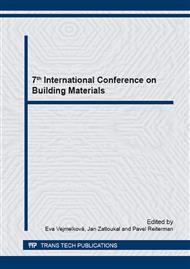p.71
p.77
p.81
p.89
p.95
p.101
p.105
p.111
p.117
Application of a Transient Method for Investigation of Water Vapour Transport Properties of Autoclaved Aerated Concrete
Abstract:
An application of a transient method for investigation of water vapour permeability of autoclaved aerated concrete is presented in the paper. Relative humidity profiles along the longitudinal axis of the rod shaped sample are measured using a transient arrangement of a diffusion experiment. Using an inverse analysis of experimentally accessed relative humidity profiles, water vapour permeability of studied material is calculated as function of relative humidity. In the inverse analysis, the Boltzmann-Matano treatment is used as the most straightforward way to the solution of inverse problems to parabolic water vapour diffusion equation.
Info:
Periodical:
Pages:
95-99
Citation:
Online since:
July 2015
Authors:
Price:
Сopyright:
© 2015 Trans Tech Publications Ltd. All Rights Reserved
Share:
Citation:


